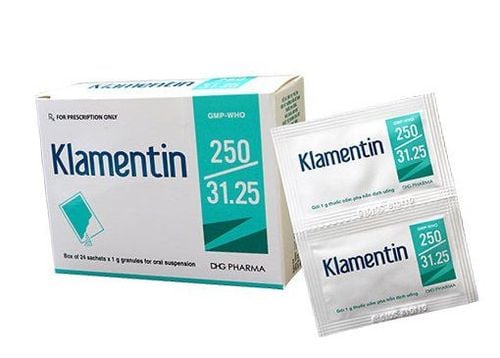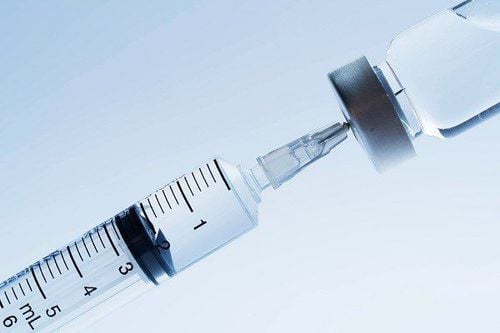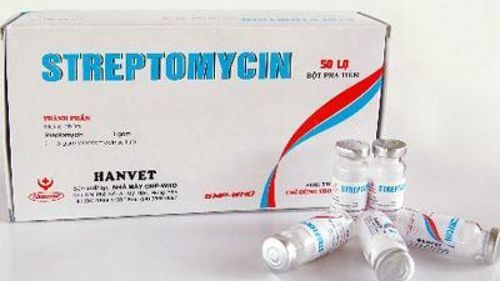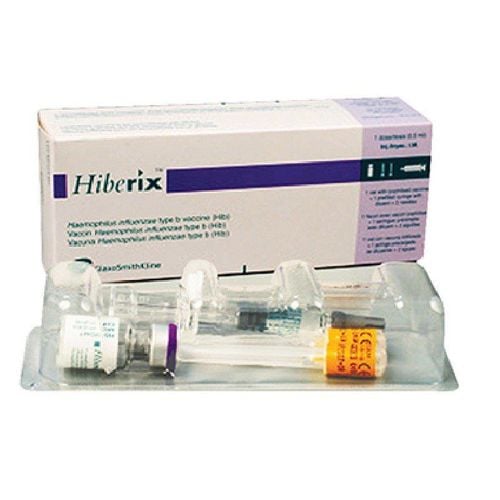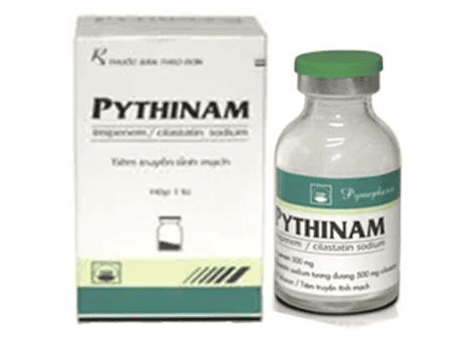This is an automatically translated article.
Claforan is an injectable prescription antibiotic. The active ingredient is Cefotaxime, a third generation Cephalosporin commonly used in the treatment of infections caused by susceptible Gram-negative and Gram-positive bacteria.
1. What is Claforan?
Claforan is a 3rd generation Cephalosporin antibiotic used to treat susceptible Gram-negative and Gram-positive infections.
Claforan contains the active ingredient Cefotaxime. Each drug product consists of a bottle of active ingredient and a tube of solvent.
The active ingredient bottle contains 1,048g Cefotaxime sodium, equivalent to 1g Cefotaxime. 4ml syringe of distilled water for injection. Antibacterial properties of Claforan :
The antibacterial activity of this drug against Gram-negative bacteria is much stronger than that of the 1st and 2nd generation Cephalosporins.
The bacteria sensitive to Cefotaxime antibiotics: S. pyogenes, Streptococcus agalactiae , Staphylococcus aureus sensitive to methicillin, S. pneumoniae, Borrelia burgdorferi, Haemophilus influenzae, Neisseria gonorrhoeae, Moraxella catarrhalis, N. meningitidis, P. vulgaris, Proteus mirabilis. Naturally resistant bacteria: Enterococcus spp, Listeria monocytogenes, methicillin-resistant Staphylococcus aureus, Acinetobacter b. ji, Pseud aerug Stenotrophi maltophilia, Clostridium difficile, Chlamydia spp, Chlamydophila spp, Legionella pneumophila, Mycoplasma spp, Treponema pallidum. Other resistant bacteria: Citrobacter freundii, Enterobacter aerogenes, E. coli, Klebsiella oxytoca, E. cloacae, K. pneumoniae, Serratia marcescens, Morganella morganii, Bacteroides fragilis.
2. Claforan drug use
Claforan is used to treat many types of bacterial infections, including severe or life-threatening forms. Indications for specific use of Claforan are as follows:
Sepsis; Endocarditis ; Meningitis (except due to Listeria monocytogenes); Lyme disease (especially in stages II and III); Respiratory tract infections; Kidney and lower urinary tract infections; Skin and soft tissue infections; Bone and joint infections; Genital infections; Severe intra-abdominal infections, including peritonitis (used in combination with Metronidazole); Prophylaxis of postoperative infections in people at high risk of infection; Combination therapy: In case of life-threatening serious infections, Claforan in combination with Aminoglycosides is indicated without waiting for the results of drug sensitivity testing. These two drugs must be used separately.
3. How to use Claforan
3.1. Some people should be careful when using Claforan Claforan should not be used by people who are allergic to this drug, Cephalosporin, Penicillin or to other beta-lactam antibiotics.
Also tell your doctor if you have:
Kidney disease; Gastrointestinal disorders; Diabetes ; Heart problems. Do not use Claforan during lactation or discontinue nursing during treatment with the drug.
Pregnant women should not use this antibiotic unless the benefits outweigh the potential risks.
3.2. Dosage of Claforan The dose, frequency and method of administration depends on the degree of infection, the sensitivity of the causative agent and the individual condition of each patient.
For adults:
Uncomplicated infections use 1g/time, 12 hours apart, intravenously (IV) or intramuscularly (IM). For moderate to severe infections, the dose is 1-2g/time, 6 to 8 hours apart, by IV or IM injection. Severe infections are life-threatening, dose 2g / time, 4 hours apart by IV injection, the maximum dose is 12g / day. For children:
Newborns: Less than 1 week old use 50mg for 1kg body weight, every 12 hours. Children from 1 to 4 weeks old: 50mg/kg, every 8 hours. Children 1 month to 12 years old weighing less than 50kg: 50 - 180mg/kg/day, divided into 4-6 equal doses. Children weighing 50kg or more: Take the same dose as adults. Meningitis and other central nervous system infections:
Adults 2g intravenously every 6 hours for 7 to 21 days. For 7 days for the treatment of uncomplicated meningitis caused by strains of Haemophilus influenzae or Neisseria meningitidis. For at least 10 to 14 days for meningitis complicated by or caused by Streptococcus pneumoniae and at least 21 days for meningitis caused by susceptible Enterobacteriaceae (Escherichia coli, Klebsiella). Children from 1 month to 12 years of age weighing less than 50kg: Use high doses in the dose range from 50 to 180mg/kg/day. Treatment of gonorrhea: Use a single intramuscular dose of 1g. With disseminated gonorrhea, children over 12 years old and adults inject 1g intravenously every 8 hours; continue taking for 1-2 days after the disease has improved; then can change to taking Cefixim for at least 7 days to completely cure the disease.
For intraoperative prophylaxis: 1g IV or IM injection, 30 to 90 minutes before surgery, may repeat the same dose depending on risk of infection.
For patients with renal failure with creatinine clearance less than 10ml/min, after the initial loading dose, the dose should be reduced by half but still keeping the same number of times a day; Maximum dose for 2g per day. In humans with creatinine clearance CrCl less than 5 ml/min, maximum daily dose of 1g, divided into 2 doses every 12 hours.
The duration of treatment depends on the patient's response. The drug should be continued for 3 to 4 days after the body temperature returns to normal. Treatment of infections caused by group A beta hemolytic streptococci should be continued for at least 10 days. Chronic urinary tract infections sometimes require treatment for several weeks.
3.3. How is Claforan used? Claforan is given by injection into a muscle (intramuscularly) or into a vein and must be mixed with liquid before use.
Intravenous injection: 1g Claforan dissolved in at least 4 ml of distilled water for injection, injected slowly over a period of 3-5 minutes.
Intravenous infusion in case a higher dose is required.
Intravenous infusion: 1-2g Claforan dissolved in 50-100ml of common infusion solution (saline solution, Ringer's solution, 5% Dextrose solution, sodium lactate solution) injected over a period of about 20 - 30 minutes. .
Do not mix sodium bicarbonate solution with Claforan .
Intramuscular: Dissolve 1g Claforan in 4ml distilled water for injection or 1% lidocaine solution; The solution is injected deep into the gluteal muscle. Do not inject more than 4ml into each side, 2g dose divided in half and injected into two different sites. It should be administered intravenously if the daily dose exceeds 2g or if Claforan is administered more than 2 times/day.
Store unmixed medicine in a dry place below 30 degrees, avoid direct light on the medicine. After mixing, the drug can be stored for 12 hours at a temperature below 25 degrees Celsius.
3.4. Overdose and Treatment Overdose symptoms may include weakness, feeling cold, pale skin, blue lips, or convulsions. Stop taking the medicine immediately and notify your doctor for timely treatment.
The antibiotic Claforan can cause diarrhea, which could be a sign of a new infection. If you have watery diarrhea or bloody stools, call your doctor, do not self-administer anti-diarrheal medicine.
3.5. Drug Interactions Some drugs can interact with Claforan such as:
Other injectable antibiotics; Diuretic; Probenecid; Cyclosporin .
4. Claforan side effects
If there are signs of an allergic reaction such as hives, difficulty breathing, swelling in the face/throat or a severe skin reaction such as fever, sore throat, burning in the eyes, skin pain, red skin rash or widespread purple, blistering, peeling, seek medical help quickly.
Call your doctor right away if Claforan can cause the following serious side effects:
Severe stomach pain, watery or bloody stools; Burns, irritation, or skin changes where the injection was given; Dark urine, yellowing of the skin/eyes; Seizures ; Fever, chills, fatigue; Easy bruising, unusual bleeding, pale skin, cold hands and feet. Common side effects of Claforan may include:
Pain, bruising, swelling, or other irritation at the injection site; Diarrhea; Fever; Rash, itching. The treatment of infections with antibiotics is prescribed by a qualified person, you need to follow the instructions you have been advised and report to the medical staff if there are abnormal signs of drug use, especially especially warning signs.
Above is all information about Claforan drug, patients need to carefully read the instructions for use, consult a doctor / pharmacist before using. Note, Claforan is a prescription drug, patients need to use the drug as prescribed by the doctor, absolutely do not self-treat at home.
Reference source: drugs.com




